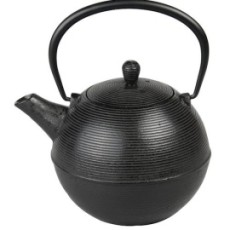Teas
Black tea
The leaves of black tea are fermented. The leaves are rolled and dried after harvest and then oxidized in a warm, moist environment. Steaming the leaves causes the fermentation process is stopped. Black tea contains no tannic acid and less antioxidants than green and white tea. Popular varieties of black tea include Ceylon, Assam, Nepal, Keemun, Darjeeling and Nilgri teas.
Many of the active substances in black tea do not develop at temperatures lower than 90 °C. The most common fault when making black tea is to use water at too low a temperature. Western black teas are usually brewed for about four minutes and are usually not allowed to steep for less than 30 seconds or more than about five minutes..
Green tea
Green tea is tea made from the leaves of the Camellia sinensis which has undergone minimal oxidation during production (fermentation) whereby natural substances are preserved. Drinking green tea originated in Japan. The tea kind is known for its health-giving properties. The tea is green because it is made from leaves of identical green plants. The harvest of the leaves may take place throughout the year. Though the best quality tea picked in the dry monsoon season. The difference between green and black tea is the treatment process.
Green tea is refreshing with a bittersweet taste. Green tea is rich in tannins, the main constituents are theophylline and theobromine. Green tea contains high concentrations of caffeine, theine and vitamin C and works on the meridians of the heart, lungs and stomach.In regions of the world that prefer mild beverage, such as the West and Far East, green tea should be steeped in water around 80 to 85 °C. The higher the quality of the leaves the lower the temperature. High-quality green and white teas can have new water added as many as five or more times, depending on variety, at increasingly higher temperatures.
White tea
White tea is an expensive and rare tea kind. For white tea only the first, young buds of the tea Bush used, which are used within 48 hours. The buttons are burned at 32 degrees and wrapped with paper. Two days after the tea is stored in wooden boxes and still twice burned on a low temperature. White tea contains little theine, plenty of antioxidants (more than the other teas) and contains lots of good nutrients. The aroma and the taste of white tea is subtle. White tea is golden yellow in color.
Oolong tea
Oolong teas should be brewed around 80 to 100 °C, and the brewing vessel should be warmed before pouring in the water. High-quality oolong can be brewed multiple times from the same leaves, and unlike green tea, it improves with reuse.
Blooming tea
Blooming tea should be brewed at 100 °C in clear glass tea wares for up to three minutes. Firstly pulling 1/3 water to make the tea ball wet and after 30 seconds adding the boiling water up to 4/5 of the tea ware.
Herbal teas
For herbal tea, of which many types of blends exist, the leaves, flowers, roots or other parts of the plant dried and ground. Tea with fruit or other flavours contain almost all black tea.
Mint tea
Where nowadays many asked is mint tea, fresh mint or crushed leaves of the mint plant. The herbal tea has nothing to do with the tea plant Camellia sinensis and therefore also not contain the substances antioxidants, polyphenols, caffeine and tannin (polyphenol tannin). The herb does have its own healthy properties.
Hibiscus tea
The dried leaves and flowers of the hibiscus is Hibiscus tea. The herbal tea has nothing to do with the tea plant Camellia sinensis and therefore also not contain the substances antioxidants, polyphenols, caffeine and tannin (polyphenol tannin). The herb does have its own healthy properties.
Rooibos tea
Of the South African Rooibos plant makes with Rooibos tea. An herbal tea without caffeine and with its own unique composition.
Herbal blends
There are also a lot of herbal teas. The leaves, flowers or roots or other parts of plants are dried and ground and made tea.
Matcha tea
This is a extreemly concentrated form of green tea, ground into powder that tea is with almost boiling water. It is supposed that this tea contains ten times more healthy substances than ordinary green tea. The tea is not drawn (only) but because the ground leaves are drunk.
Antioxidants
Antioxidants you will find in almost all teas, white tea comes out above the rest. White tea contains per head average 125 mg antioxidants and 15 mg of caffeine. Followed by green tea with an average of 100 mg of antioxidants and 20 mg of caffeine. This is followed by 40 mg, 45, while black tea Rooibos tea contains 20 to 0 mg. To make a comparison with coffee, it contains about 75 mg of caffeine per Cup.
